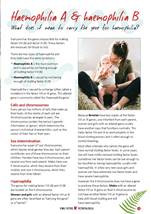Haemophilia A & haemophilia B
Everyone has the genes responsible for making factor VIII (8) and factor IX (9). These factors are necessary for blood to clot.
There are two types of haemophilia and they both have the same symptoms:
- Haemophilia A is the most common and is caused by not having enough of clotting factor VIII (8)
- Haemophilia B is caused by not having enough of clotting factor IX (9)
Haemophilia is caused by a change (often called a mutation) in the factor VIII or IX gene. This altered gene is commonly called the ‘haemophilia gene’.
Women and girls with an altered factor VIII or IX gene are often described as “carrying the gene” or a “carrier”.
Factor levels and bleeding symptoms
Most often a female who carries the gene will have normal clotting factor levels and will not have symptoms of a bleeding disorder.
In some cases she will have mildly reduced clotting factor levels. Sometimes her factor levels can be low enough for to be classified as having haemophilia, usually mild haemophilia (5-40% of normal clotting factor). In a few very rare cases girls and women can have extremely low factor levels and have severe haemophilia.
Some females with factor levels between 40% and 60% may also experience abnormal bleeding.
Inheritance
If you are a female who carries the gene for haemophilia or you are a male with haemophilia, you will have an alteration in your factor VIII (8) or IX (9) gene. This altered gene may be passed on to your children.
If you are a female who carries the gene, there is a 50% chance with each of your pregnancies that you will pass the altered gene onto your baby:
- If you have a son who inherits the gene, he will have haemophilia.
- If you have a daughter who inherits the gene, she will carry the gene too.
If you are a male with haemophilia:
- All (100%) of your daughters will inherit the altered gene from you and will carry the gene
- None of your sons will have haemophilia.
More information
Contact details of Haemophilia Treatment Centres in Australia are available on the HFA website.
I f you’d like to know more about haemophilia A and B download our Female Factors resource here. This contains more information on Haemophilia A and B including:
f you’d like to know more about haemophilia A and B download our Female Factors resource here. This contains more information on Haemophilia A and B including:
- What does it mean to carry the gene for haemophilia?
- Inheritance
- Bleeding symptoms
- Female bleeding patterns
- The calico cat
 For more information on bleeding disorders in young women read our full Female Factors resource here
For more information on bleeding disorders in young women read our full Female Factors resource here